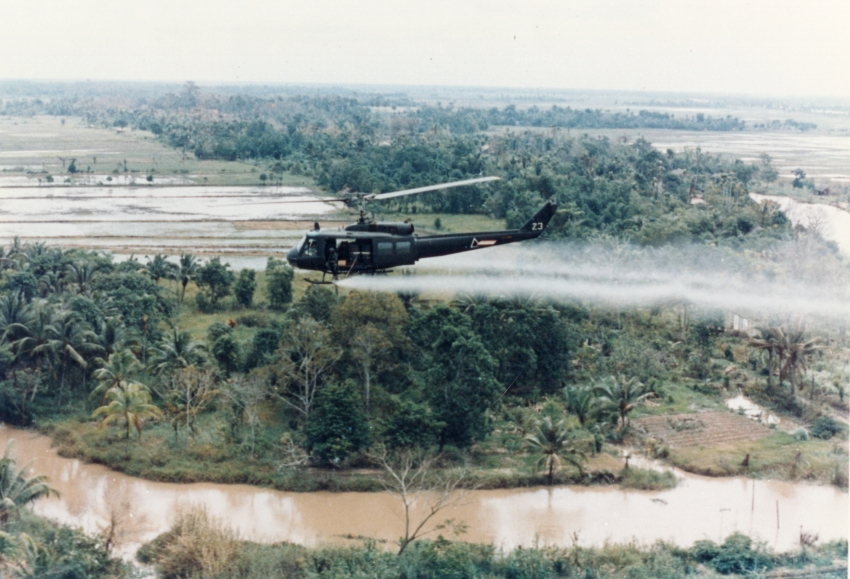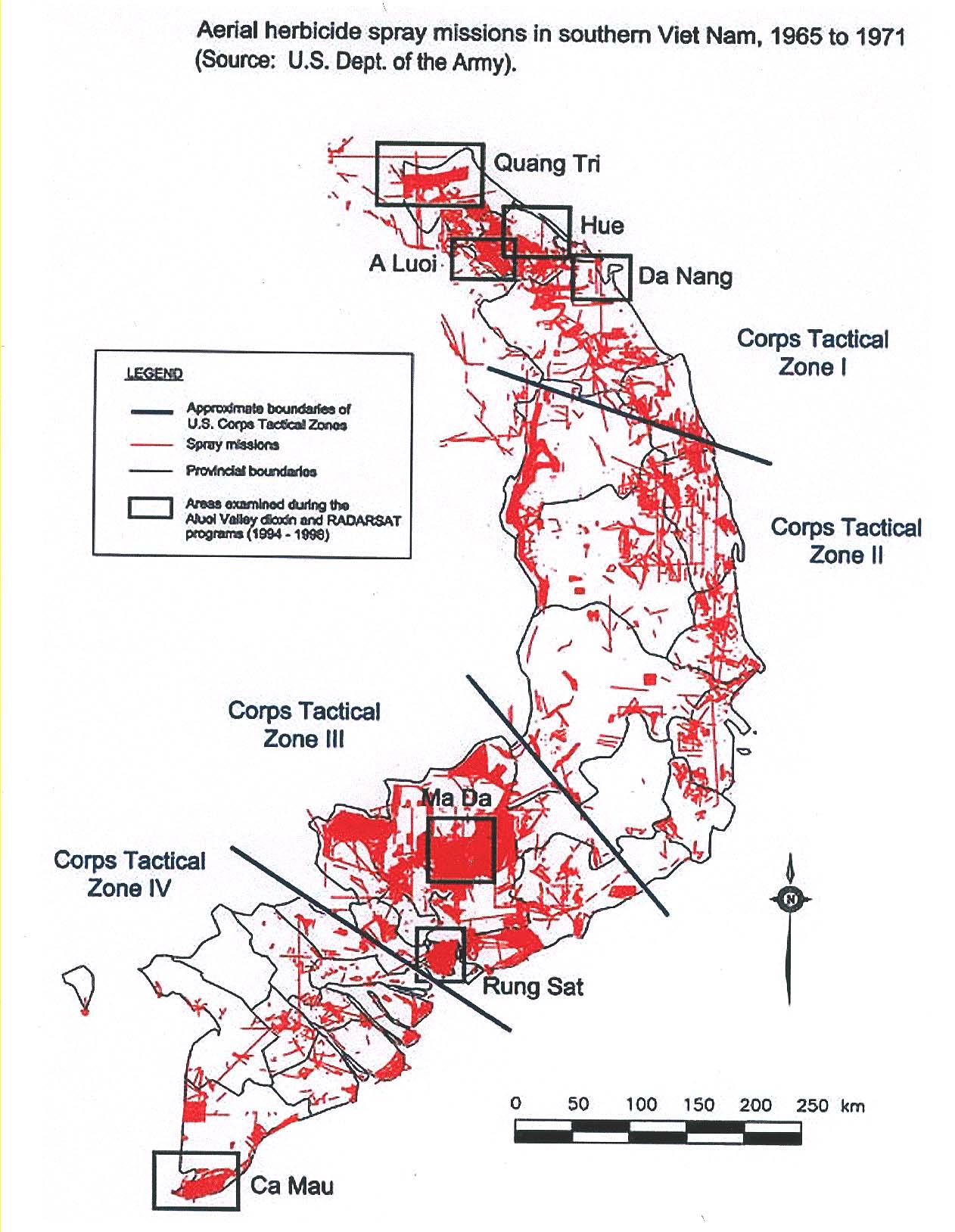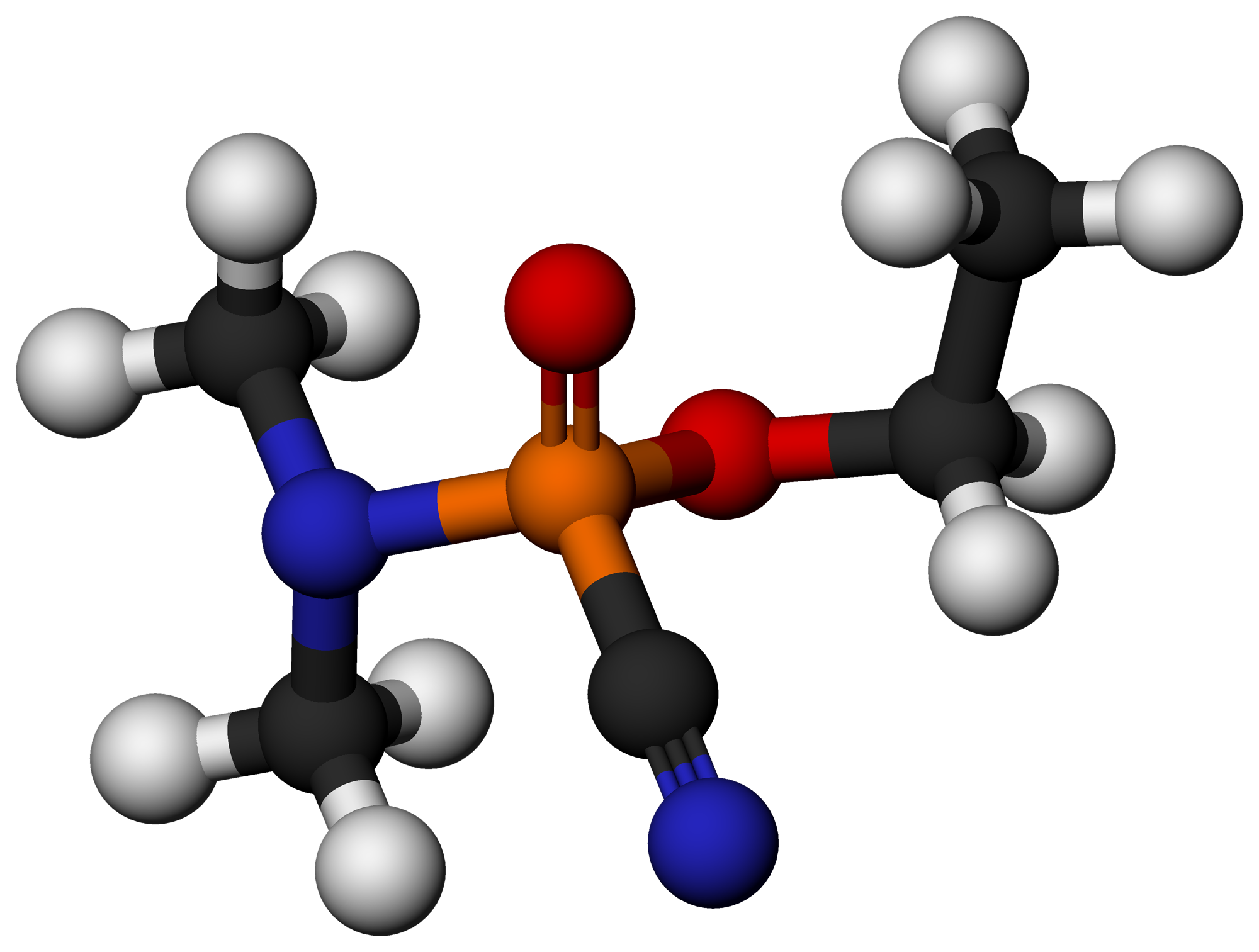|
Operation Pacer IVY
Operation Pacer Ivy was a 1972 operation of the U.S. Air Force that removed Agent Orange from South Vietnam and stored it on Johnston Atoll. IVY was presumably selected as an abbreviation of InVentorY.The History, Use, Disposition and Environmental Fate of Agent Orange By Alvin Lee Young, Springer, April 28, 2009, page 123: , , Operation Pacer HO refers to an associated program of the United States Department of Defense (DoD), dealing with the disposition of Agent Orange from Vietnam. Purpose On 15 April 1970, the Assistant Secretary of Defense suspended the use of Herbicide Orange (HO), a defoliant spray mixture during the Vietnam War. The suspension lasted from April 15, 1970, to September 13, 1971. On September 13, 1971, the Secretary directed the Chairman of the Joint Chiefs of Staff that “all stocks of Herbicide Orange in Vietnam will be returned to the Continental United States as quickly as practicable for disposition. A joint State Department and Defense Dep ... [...More Info...] [...Related Items...] OR: [Wikipedia] [Google] [Baidu] |
Agent Orange
Agent Orange is a chemical herbicide and defoliant, one of the "tactical use" Rainbow Herbicides. It was used by the U.S. military as part of its herbicidal warfare program, Operation Ranch Hand, during the Vietnam War from 1961 to 1971. It is a mixture of equal parts of two herbicides, 2,4,5-T and 2,4-D. In addition to its damaging environmental effects, traces of dioxin (mainly TCDD, the most toxic of its type) found in the mixture have caused major health problems for many individuals who were exposed, and their offspring. Agent Orange was produced in the United States from the late 1940s and was used in industrial agriculture and was also sprayed along railroads and power lines to control undergrowth in forests. During the Vietnam War, the U.S. military procured over 20 million gallons consisting of a fifty-fifty mixture of 2,4-D and dioxin-contaminated 2,4,5-T. Nine chemical companies produced it: Dow Chemical Company, Monsanto Company, Diamond Shamrock Corporation, ... [...More Info...] [...Related Items...] OR: [Wikipedia] [Google] [Baidu] |
Okinawa
is a prefecture of Japan. Okinawa Prefecture is the southernmost and westernmost prefecture of Japan, has a population of 1,457,162 (as of 2 February 2020) and a geographic area of 2,281 km2 (880 sq mi). Naha is the capital and largest city of Okinawa Prefecture, with other major cities including Okinawa, Uruma, and Urasoe. Okinawa Prefecture encompasses two thirds of the Ryukyu Islands, including the Okinawa, Daitō and Sakishima groups, extending southwest from the Satsunan Islands of Kagoshima Prefecture to Taiwan ( Hualien and Yilan Counties). Okinawa Prefecture's largest island, Okinawa Island, is the home to a majority of Okinawa's population. Okinawa Prefecture's indigenous ethnic group are the Ryukyuan people, who also live in the Amami Islands of Kagoshima Prefecture. Okinawa Prefecture was ruled by the Ryukyu Kingdom from 1429 and unofficially annexed by Japan after the Invasion of Ryukyu in 1609. Okinawa Prefecture was officially founded in 1879 by the Empi ... [...More Info...] [...Related Items...] OR: [Wikipedia] [Google] [Baidu] |
Weapon Storage Area
{{unreferenced, date=November 2014 Weapon storage areas (WSA), also known as special ammunition storage (SAS), were extremely well guarded and well defended locations where NATO nuclear weapons were stored during the Cold War era. In most situations, the WSA or SAS areas were located inside the perimeter of an army barracks or an air base in NATO territory, but in a few cases they were located deep inside wooded areas and miles away from a military base. Due to changes in the political landscape, the number of special weapons in Europe has been drastically decreased. Moreover, the introduction of the WS3 Weapon Storage and Security System has made WSAs obsolete. At present, few WSAs are still operational as modern day special weapons are stored in the floors of concrete aircraft shelters and placed under 24/7 electronic surveillance. Examples *Bossier Baseformer WSA*Killeen Base *Lake Mead Base/Nellis Area 2 *Manzano Base *Medina Annex prior to NSA/CSS Texas Cryptologic Center b ... [...More Info...] [...Related Items...] OR: [Wikipedia] [Google] [Baidu] |
Saigon
, population_density_km2 = 4,292 , population_density_metro_km2 = 697.2 , population_demonym = Saigonese , blank_name = GRP (Nominal) , blank_info = 2019 , blank1_name = – Total , blank1_info = US$61.7 billion , blank2_name = – Per capita , blank2_info = US$6,862 , blank3_name = GRP ( PPP) , blank3_info = 2019 , blank4_name = – Total , blank4_info = US$190.3 billion , blank5_name = – Per capita , blank5_info = US$21,163 , blank6_name = HDI (2020) , blank6_info = 0.795 ( 2nd) , area_code = 28 , area_code_type = Area codes , website = , timezone = ICT , utc_offset = +07:00 , postal_code_type = Postal code , postal_code = 700000–740000 , iso_code ... [...More Info...] [...Related Items...] OR: [Wikipedia] [Google] [Baidu] |
Tuy Hoa Air Base
Căn cứ không quân Tuy Hòa is a former air force base in Vietnam, being closed in 1970. It was built by the United States in 1966 and was used by the United States Air Force (USAF) during the Vietnam War in the II Corps Tactical Zone of South Vietnam. It was captured by the People's Army of Vietnam in April 1975 and was abandoned for several decades. Today, the site has been redeveloped as Cảng Hàng Không Tuy Hòa USAF use In September 1965 Tuy Hoa was identified as a potential site for an air base and in October, following feasibility and soil studies, CINCPAC recommended construction of a base there. Military Assistance Command, Vietnam (MACV) originally opposed the decision based on cost, logistical, construction capacity/manpower and security concerns, but in December it agreed to begin construction in January 1966. However, in January construction was postponed by MACV in favour of constructing Phù Cát Air Base. In order to speed up construction of the Tuy H ... [...More Info...] [...Related Items...] OR: [Wikipedia] [Google] [Baidu] |
Cam Ranh Bay
Cam Ranh Bay ( vi, Vịnh Cam Ranh) is a deep-water bay in Vietnam in Khánh Hòa Province. It is located at an inlet of the South China Sea situated on the southeastern coast of Vietnam, between Phan Rang and Nha Trang, approximately 290 kilometers (180 miles) northeast of Ho Chi Minh City (formerly Saigon). Cam Ranh is considered the finest deepwater shelter in Southeast Asia. The continental shelf of Southeast Asia is relatively narrow at Cam Ranh Bay, bringing deep water close to land. Since 2011-2014, Vietnamese authorities have hired Russian consultants and purchased Russian technologies to re-open Cam Ranh Bay (a former United States and later Soviet military base) as the site of a new naval maintenance and logistics facility for foreign warships. Overview Historically, the bay has been significant from a military standpoint. The French used it as a naval base for their forces in Indochina. It was also used as a staging area for the 40-ship Imperial Russian fleet u ... [...More Info...] [...Related Items...] OR: [Wikipedia] [Google] [Baidu] |
Da Nang
Nang or DanangSee also Danang Dragons ( ; vi, Đà Nẵng, ) is a class-1 municipality and the fifth-largest city in Vietnam by municipal population. It lies on the coast of the East Sea of Vietnam at the mouth of the Hàn River, and is one of Vietnam's most important port cities. As one of the country's five direct-controlled municipalities, it falls under the administration of the central government. Da Nang is the commercial and educational centre of Central Vietnam and is the largest city in the region. It has a well-sheltered, easily accessible port, and its location on National Route 1 and the North–South Railway makes it a transport hub. It is within of several UNESCO World Heritage Sites, including the Imperial City of Huế, the Old Town of Hội An, and the Mỹ Sơn ruins. The city was known as during early Đại Việt settlement, and as (or ''Turon'') during French colonial rule. Before 1997, the city was part of Quang Nam - Da Nang Province. On 1 Janua ... [...More Info...] [...Related Items...] OR: [Wikipedia] [Google] [Baidu] |
Chemical Weapons
A chemical weapon (CW) is a specialized Ammunition, munition that uses chemicals chemical engineering, formulated to inflict death or harm on humans. According to the Organisation for the Prohibition of Chemical Weapons (OPCW), this can be any chemical compound intended as a weapon "or its Precursor (chemistry), precursor that can cause death, injury, temporary incapacitation or sensory irritation through its chemical action. Munitions or other delivery devices designed to deliver chemical weapons, whether filled or unfilled, are also considered weapons themselves." Chemical weapons are classified as weapons of mass destruction (WMD), though they are distinct from nuclear weapons, biological warfare, biological weapons, and radiological weapons. All may be used in warfare and are known by the military acronym NBC (for nuclear, biological, and chemical warfare). Weapons of mass destruction are distinct from conventional weapons, which are primarily effective due to their explos ... [...More Info...] [...Related Items...] OR: [Wikipedia] [Google] [Baidu] |
Agent Orange
Agent Orange is a chemical herbicide and defoliant, one of the "tactical use" Rainbow Herbicides. It was used by the U.S. military as part of its herbicidal warfare program, Operation Ranch Hand, during the Vietnam War from 1961 to 1971. It is a mixture of equal parts of two herbicides, 2,4,5-T and 2,4-D. In addition to its damaging environmental effects, traces of dioxin (mainly TCDD, the most toxic of its type) found in the mixture have caused major health problems for many individuals who were exposed, and their offspring. Agent Orange was produced in the United States from the late 1940s and was used in industrial agriculture and was also sprayed along railroads and power lines to control undergrowth in forests. During the Vietnam War, the U.S. military procured over 20 million gallons consisting of a fifty-fifty mixture of 2,4-D and dioxin-contaminated 2,4,5-T. Nine chemical companies produced it: Dow Chemical Company, Monsanto Company, Diamond Shamrock Corporation, ... [...More Info...] [...Related Items...] OR: [Wikipedia] [Google] [Baidu] |
Mustard Gas
Mustard gas or sulfur mustard is a chemical compound belonging to a family of cytotoxic and blister agents known as mustard agents. The name ''mustard gas'' is technically incorrect: the substance, when dispersed, is often not actually a gas, but is instead in the form of a fine mist of liquid droplets.https://www.acs.org/content/dam/acsorg/education/resources/highschool/chemmatters/gc-mustard-gas-personal-safety-and-natl-security.pdf Mustard gases form blisters on exposed skin and in the lungs, often resulting in prolonged illness ending in death. The active ingredient in typical mustard gas is the organosulfur compound bis(2-chloroethyl) sulfide. In the wider sense, compounds with the structural element are known as ''sulfur mustards'' and ''nitrogen mustards'', respectively. Such compounds are potent alkylating agents, which can interfere with several biological processes. History as chemical weapons As a chemical weapon, mustard gas was first used in World War I, and has ... [...More Info...] [...Related Items...] OR: [Wikipedia] [Google] [Baidu] |
Nerve Agent
Nerve agents, sometimes also called nerve gases, are a class of organic chemicals that disrupt the mechanisms by which nerves transfer messages to organs. The disruption is caused by the blocking of acetylcholinesterase (AChE), an enzyme that catalyzes the breakdown of acetylcholine, a neurotransmitter. Nerve agents are acetylcholinesterase inhibitors used as poison. Poisoning by a nerve agent leads to constriction of pupils, profuse salivation, convulsions, and involuntary urination and defecation, with the first symptoms appearing in seconds after exposure. Death by asphyxiation or cardiac arrest may follow in minutes due to the loss of the body's control over respiratory and other muscles. Some nerve agents are readily vaporized or aerosolized, and the primary portal of entry into the body is the respiratory system. Nerve agents can also be absorbed through the skin, requiring that those likely to be subjected to such agents wear a full body suit in addition to a respirato ... [...More Info...] [...Related Items...] OR: [Wikipedia] [Google] [Baidu] |








